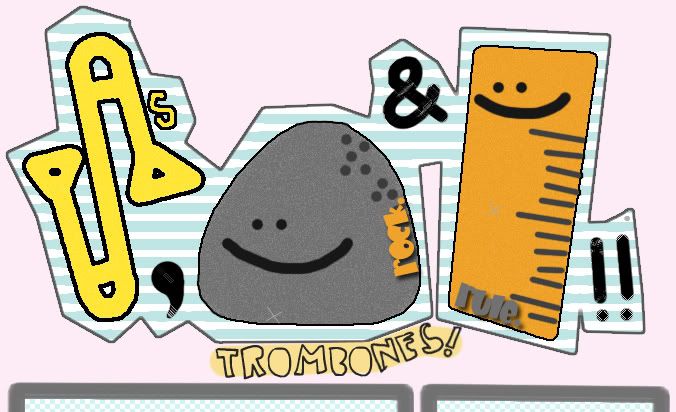
LOVEUS;
NYCB'S TROMBONE section that has EIGHT fun nice cute pretty proded sexy gorgeous
fab lovable intelligent tall and short people.


PLAYERS;
Batch '16
Hui Ling
Batch '15
Sze Kay
Xuan Ting
Batch '14
Justine
Lilian
Yu Kee
Batch '13
Emily
Lynette
Batch '12
JiaHui
YuXin
Batch '11
Clarissa
Joei
Michelle
Batch '10
Rie
Theodora
Wanting
Batch '09
Clarice
Sarah
Pamela
Batch '08
Jo
Valerie
YunJia
Batch '07
Shimin
Samantha
BIRTHDAYS<3
Sarah 010194
JiaHui 110196
Sze Kay 250199
Yu Kee 050298
Shimin 110291
Emily 240297
Hui Ling 030300
Lynette 100397
Theodora 160394
Joei 310395
Jo 210492
Rie 220494
Samantha 080591
Valerie 150592
Pamela 270793
Justine 280798
Yunjia 270892
Lilian 080998
Michelle 160995
YuXin 041096
Clarice 171093
Wan Ting 201194
Clarissa 301195
Xuan Ting 251299
Seniors :)
Rochelle
Shinni
Valerie
Sunyang
Vivian
Monica
Yingxu
Samantha
Shimin
Valerie
Jo
Yunjia
Clarice
Pamela
Sarah
Rie
Theodora
Wanting
Clarissa
Joei
Michelle
BLAH;
GONE;
US
yingxu.
shimin.
valerie.
jo.
sarah.
pamela.
clarice.
wanting.
theodora.
rie.
michelle.
joei.
yuxin.
jiahui.
emily.
NYCB
alena.
alicia.
amandachan.
amandalee.
annabelle.
anne.
beilin.
beishi
celine.
charis.
charlotte.
cherie.
cherylho.
cheryllee.
cheryltong.
chingying.
chungyan.
chunhui.
clara.
cynthia.
esther.
fangyi
germaine.
guakhee.
guoying.
huishan.
huizhen.
jacey.
jaclyn.
jane.
jiaying.
jingyi.
jityee.
jinny.
joan.
joy.
judy.
junqi.
kayla.
kayyun.
kexin.
keyecheng.
lishuen.
liting.
liwei.
lorraine.
maoyu.
maureen.
meian.
meiqi.
mellissa.
mingsei.
nicole.
patricia.
pearlynne.
peisan.
peiwei.
qianwen.
qiuluan.
quinza.
rachel.(tpts)
rachel.(flutes)
rachelle.
rae.
rosalind.
rouhui.
sabrina.
sandy.
sarahong.
serene.
sherlyn.
sheryl.
shuyuin.
siewrong.
siewying.
silei.
sunran.
suyi.
sylvia.
sylvia.
tasha.
tianhui.
valentia.
valerieLim.
vania.
vera.
wanlin.
wanyu.
wenting.
xiaohui.
xichen.
xinyi.
yiting.
yufei.
yunxin.
yuzhen.
ziyan.
SECTIONS
clarinets.
euphos.
fluboes.
horns.
percussion.
saxes.
scones(batch'09).
batch'12.
batch'11.
batch'10.
trumpets.
band photos :D
more band photos :DD
REWIND;
June 2007 July 2007 August 2007 September 2007 November 2007 December 2007 January 2008 February 2008 March 2008 April 2008 May 2008 June 2008 July 2008 August 2008 September 2008 October 2008 November 2008 December 2008 January 2009 February 2009 March 2009 April 2009 May 2009 June 2009 July 2009 August 2009 September 2009 October 2009 November 2009 December 2009 January 2010 February 2010 March 2010 April 2010 May 2010 June 2010 July 2010 August 2010 November 2010 January 2011 February 2011 March 2011 April 2011 May 2011 June 2011 September 2011 January 2012 May 2012 June 2012 August 2012 March 2013 April 2013
NYCB'S TROMBONE section that has EIGHT fun nice cute pr


PLAYERS;
Batch '16
Hui Ling
Batch '15
Sze Kay
Xuan Ting
Batch '14
Justine
Lilian
Yu Kee
Batch '13
Emily
Lynette
Batch '12
JiaHui
YuXin
Batch '11
Clarissa
Joei
Michelle
Batch '10
Rie
Theodora
Wanting
Batch '09
Clarice
Sarah
Pamela
Batch '08
Jo
Valerie
YunJia
Batch '07
Shimin
Samantha
BIRTHDAYS<3
Sarah 010194
JiaHui 110196
Sze Kay 250199
Yu Kee 050298
Shimin 110291
Emily 240297
Hui Ling 030300
Lynette 100397
Theodora 160394
Joei 310395
Jo 210492
Rie 220494
Samantha 080591
Valerie 150592
Pamela 270793
Justine 280798
Yunjia 270892
Lilian 080998
Michelle 160995
YuXin 041096
Clarice 171093
Wan Ting 201194
Clarissa 301195
Xuan Ting 251299
Seniors :)
Rochelle
Shinni
Valerie
Sunyang
Vivian
Monica
Yingxu
Samantha
Shimin
Valerie
Jo
Yunjia
Clarice
Pamela
Sarah
Rie
Theodora
Wanting
Clarissa
Joei
Michelle
BLAH;
GONE;
US
yingxu.
shimin.
valerie.
jo.
sarah.
pamela.
clarice.
wanting.
theodora.
rie.
michelle.
joei.
yuxin.
jiahui.
emily.
NYCB
alena.
alicia.
amandachan.
amandalee.
annabelle.
anne.
beilin.
beishi
celine.
charis.
charlotte.
cherie.
cherylho.
cheryllee.
cheryltong.
chingying.
chungyan.
chunhui.
clara.
cynthia.
esther.
fangyi
germaine.
guakhee.
guoying.
huishan.
huizhen.
jacey.
jaclyn.
jane.
jiaying.
jingyi.
jityee.
jinny.
joan.
joy.
judy.
junqi.
kayla.
kayyun.
kexin.
keyecheng.
lishuen.
liting.
liwei.
lorraine.
maoyu.
maureen.
meian.
meiqi.
mellissa.
mingsei.
nicole.
patricia.
pearlynne.
peisan.
peiwei.
qianwen.
qiuluan.
quinza.
rachel.(tpts)
rachel.(flutes)
rachelle.
rae.
rosalind.
rouhui.
sabrina.
sandy.
sarahong.
serene.
sherlyn.
sheryl.
shuyuin.
siewrong.
siewying.
silei.
sunran.
suyi.
sylvia.
sylvia.
tasha.
tianhui.
valentia.
valerieLim.
vania.
vera.
wanlin.
wanyu.
wenting.
xiaohui.
xichen.
xinyi.
yiting.
yufei.
yunxin.
yuzhen.
ziyan.
SECTIONS
clarinets.
euphos.
fluboes.
horns.
percussion.
saxes.
scones(batch'09).
batch'12.
batch'11.
batch'10.
trumpets.
band photos :D
more band photos :DD
REWIND;
June 2007 July 2007 August 2007 September 2007 November 2007 December 2007 January 2008 February 2008 March 2008 April 2008 May 2008 June 2008 July 2008 August 2008 September 2008 October 2008 November 2008 December 2008 January 2009 February 2009 March 2009 April 2009 May 2009 June 2009 July 2009 August 2009 September 2009 October 2009 November 2009 December 2009 January 2010 February 2010 March 2010 April 2010 May 2010 June 2010 July 2010 August 2010 November 2010 January 2011 February 2011 March 2011 April 2011 May 2011 June 2011 September 2011 January 2012 May 2012 June 2012 August 2012 March 2013 April 2013
Saturday, February 26, 2011
listen.
&loveTROMBONES; 2:21 pm
Thursday, February 10, 2011
Hope this article will be useful :)
Brass Basics by Philip T. Cansler
October 13, 2010
Written by Philip T. Cansler / republished with permission from Conn Selmer Keynotes Magazine
Philip T. Cansler has taught in the performing and fine arts department at the University of Portland for 25 years and has published several books and numerous articles on the trumpet and brass playing. He can be reached at cansler@up.edu
These simple practice tips can lead to better playing – and a fuller life
We live in a busy world, but brass players, like all musicians, need to set aside sufficient time each day to practice. It lays the firm foundation on which we build our musicianship. By working on what is most important to improve our playing, we can practice smarter – more efficiently – and have more time for living.
Tone is the most important aspect of playing any instrument, and making tone a priority is essential to longevity as a brass player. During practice sessions, devote fifteen minutes each day to tone development. Here are three areas to cover daily.
Mouthpiece practice
James Stamp can be credited for popularizing mouthpiece practice. I have found that students with tone problems improve vastly with a few weeks of mouthpiece playing for five to ten minutes a day.
A brass instrument is an amplifier: when the lip vibrates into the mouthpiece, the instrument amplifies the sound. Some players have a technique producing a sound that may be acceptable on the instrument but horrid on the mouthpiece alone. If you make sure the lips start together and then gradually work the lower lip into the mouthpiece, the tone improves dramatically on the mouthpiece alone.
When you place the mouthpiece back on your instrument, you will sound like a different player. Practicing on the mouthpiece immediately after your warm-up will focus your ear on tone.
The embouchure we should strive for can be characterized as having the lower lip pouting inside the mouthpiece, which creates the beautiful, rich sounds we hear from great brass artists. Maynard Ferguson tells students that he plays high notes by gripping the mouthpiece. He is essentially talking about gripping the inside of the mouthpiece with his lower lip.
To develop your tone, try practicing any arpeggio exercise or passage (but avoid the high register). First play the passage on your instrument. Now create the clearest tone possible on the mouthpiece alone by working your lower lip into the mouthpiece. Once this mouthpiece tone has been improved, play it again on your instrument – and be prepared to hear a noticeable difference.
Lip bends
Practicing lip bends is actually a continuation of the concept learned from mouthpiece practice. It is an isometric exercise to develop the lower lip so it can grip the mouthpiece. Isometrics have been known for years as a solid means of building muscle.
Yoga exercises, for example, are based on isometrics, toning and firming muscles through daily repetition. Similarly, for the brass player, lip bends isolate and strengthen the lower lip muscles.
Lip bends are actually note-bending exercises. Practice by playing a middle C (on the trumpet), then the half-step-lower B (second valve), then back to C. Now play the C, and use the lower lip muscle to push into the mouthpiece, which bends the C down to the B (without using the second valve). As you withdraw the lower lip, the C comes back again. Avoid kissing the mouthpiece with both lips.
Practice the lower lip roll first by pouting in a mirror. Once you have isolated the lower lip muscle, apply the technique to your instrument. Go down by half steps, recreating the half-step lower notes with your lower lip.
The notes that are lowered without the new fingerings should sound almost as good as the “real” notes. After going through all seven positions, return to C and lip down two half steps.
After the muscles begin to develop and you start feeling some control in the lower lip (usually in one to two weeks), you can start on second line G (for trumpet) and bend the notes down by half steps through the seven positions. Each week, as you feel the progress in your lip, you can start on a higher open note.
Notes produced by bending will not be used during gigs. But the excitement you will feel when playing a high C – with the lower lip gripping the mouthpiece so firmly that you know the high C won’t crack – will have you going back to practice lip bends for years to come.
Warm-down
One of the most critical practices to follow before putting the instrument away is the warm-down. Few of us are able to play for an extended period, put the instrument away, and encounter no problems the next time the horn comes out of the case.
Brass players have consistency problems mainly because they bypass the warm-down. Lip muscles get tight after extended play and need to relax before stopping.
It takes only three to five minutes to relax the lips. Pedal tones are a great lip massage and will relax the muscles. Try playing a middle C, then drop the air speed and pull the mouthpiece off the lip slightly. The note should fall off to approximately an octave below, and the entire lip in the mouthpiece will pulsate. Continue through the seven positions, dropping an octave.
Next, try soft chromatics. Starting on middle C, go down through all seven positions and back up as softly as you can. If notes cut out, your lip is not relaxed enough and the lips are separating.
Go back and do more pedal tones. Once you are able to play the lowest seven notes on your instrument softly without response problems, your lips are relaxed enough to put the instrument away.
If you are preparing for a special performance, warm down ten minutes the night before, with soft, low playing. The next day, your lips will be highly responsive.
So rethink your practice. Adding new concepts to your daily routine can improve your performance immensely.
Remember, it is not the time on the instrument that counts, but what and how you practice. Practice more efficiently, and you will not only notice improvements in your playing, but you will also find more time for that elusive balanced life.
http://www.sgbandfusion.com/2010/10/brass-basics-by-philip-t-cansler/
&loveTROMBONES; 9:30 pm
Tuesday, February 01, 2011
Hello! :) Randomly decided to post this on section blog... Please listen to it! (If you guys people even see this haha.) It's cool! (can hear so many inside parts :D ) yeahh but do take note of how they play (: btw HAPPY CHINESE NEW YEAR!!! :)
-ssa
&loveTROMBONES; 10:49 pm